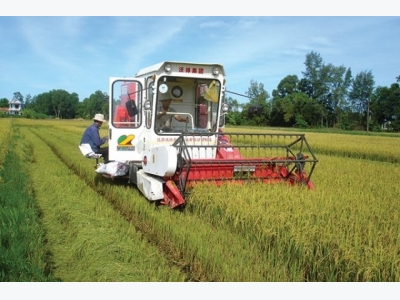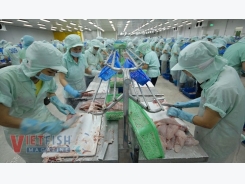Cultivating technology

Photo: Viet Tuan
Calls have long rung out for Vietnam to mechanize its agriculture sector, and manufacturers, both local and foreign, are keen to meet needs.
At the end of the winter-spring rice crop this year, farmers in Dien Chau district in north-central Nghe An province were very happy with the size of the crop grown under mechanized production. Using a modern combine harvester for the harvest helped them cut costs by 15-20 per cent compared to manual methods. Agricultural machinery has replaced human labor in plowing, harvesting and transport by 90 per cent in Dien Chau district and on average has cut costs by between VND1.5 and VND2 million ($66 and $88) per ha.
The farmers’ happiness will continue into the next rice season as district authorities have decided to purchase 12 combine harvesters and tractors for growing and harvesting rice. Many other localities throughout Vietnam have stepped up mechanization in a move towards large-scale agricultural production, in line with government goals, which represents a major opportunity for enterprises producing and selling such machinery.
Demand on the up
The number of machines now used in the agriculture sector has increased very quickly over the last decade, according to the Vietnam Institute of Agricultural Engineering & Post-Harvest Technology at the Ministry of Agriculture and Rural Development (MARD). Certain types have increased faster than others, with the number of rice harvesters rising 25.6-fold, plant protection spray equipment six-fold, and water pumps 1.2-fold.
The demand for modern agricultural machinery to support a closed value chain is continually on the rise. One of the leading sugar manufacturers in the country, Thanh Thanh Cong Tay Ninh JSC (TTCS), aims to build a 30,000-ha raw material area to ensure a stable supply of sugarcane to its refineries, which require 2.3 million tons annually. In order to achieve high efficiency in sugarcane cultivation and harvesting, the local government has broadened mechanization, especially investment in tractors and irrigation systems.
Recognizing the opportunity, the TTC Group, the owner of TTCS, signed a partnership in July with John Deere, the US agricultural equipment giant, to develop deep plowing equipment and tractors with engines of 90 to 245 horsepower that are capable of plowing at least 40 centimeters in depth in a variety of terrain. Deep plowing helps sugarcane cope with any changes in the weather. TTC will also become John Deere’s official dealer in Vietnam.
Meanwhile, to serve large-scale clean farming, VinEco, a subsidiary of Vingroup, signed a cooperative agreement with three of the world’s leading suppliers of high-tech agricultural production equipment, worth more than VND1 trillion ($44 million). The three partners come from well-known agriculture groups: NETAFIM and Teshuva Agricultural Projects (TAP) from Israel and KUBOTA from Japan. The two countries have the most advanced agriculture sectors in the world, with particular strengths in researching, developing, and optimizing the effective application of technological advances in production.
The partners will provide VinEco with a high-tech platform for safe agricultural production on a large scale under VietGap and GlobalGap standards. Specifically, TAP and NETAFIM will provide up to 60 ha of greenhouses with automatic irrigation systems and active nutrient supply systems on an area of nearly 1,000 ha in the first phase. KUBOTA, meanwhile, will provide mechanized and automated technology on large areas at all VinEco farms throughout the country.
Thai Binh Seed, one of the leading seed companies in Vietnam, signed a cooperation agreement with EVERTON from Japan at the Vietnam Investment Promotion Conference in Japan in July, to supply and install modern agricultural dryer systems for seed preservation and storage. Mr. Tran Manh Bao, CEO of Thai Binh, said the company believes such deals will help businesses in Vietnam develop strongly in the future.
Despite the high demand, actual automation and mechanization in rice planting and harvesting remains low in Vietnam. The Mekong Delta has more than 5,500 harvesters being used on only 40 per cent of its farmland, while rice planting machinery covers just 30 per cent. Automation and mechanization in vegetable production is much lower than in rice production. In general, the Mekong Delta has machines with 1.6 horsepower per hectare, while the figure in Thailand is four, China eight, and South Korea ten.
Automation and mechanization in agricultural production will increase labor productivity, reduce costs, and increase competitiveness for farmers, Mr. Dr. Vo Hung Dung, Director of the Vietnam Chamber of Commerce and Industry’s Can Tho branch, told VET. “The potential for the development of automation and mechanization in Vietnam’s agricultural production is huge,” he added.
Eye-catching market
Seeing that potential, many foreign businesses have recently been eyeing the country’s agricultural machinery market. During a recent visit to Vietnam, an Italian business delegation expressed interest in the market. Agricultural machinery and pharmaceuticals are two attractive areas for Italian investors seeking investment opportunities in Vietnam in the years to come, according to Mr. Pham Hoang Hai, Secretary Generale and Executive Director of the Italian Chamber Commerce in Vietnam (ICHAM). Many Italian businesses are looking for opportunities to boost their exports of machinery, especially agricultural machinery, to Vietnam because demand is on the increase.
The importation of Italian machinery has been limited in the past because of their rather high prices. “Though the price of Italian machinery is cheaper than German machinery, support policies for enterprises to buy machinery remains poor,” Mr. Hai said. “Therefore, ICHAM is coordinating with agencies and banks to offer financial products to help Vietnamese businesses borrow money to purchase machinery from Italy.”
Ms. Carlotta Colli, the Italian Consul General in Ho Chi Minh City, said that Vietnam is a developing country based on agriculture, and so is a market of potential for agriculture machinery and technology. Italy is strong in the sector and can support the development of Vietnam’s high-tech agriculture and mechanization. More than 65 per cent of agricultural machinery produced in Italy has been exported to more than 180 countries around the world, with export turnover to ASEAN countries increasing since 2014 and is expected to grow further in the years to come.
Many Indian investors are also keen on Vietnam’s agriculture machinery market. According to Mr. Jasmeet Singh, Head of Agriculture at the Federation of Indian Chamber of Commerce and Industry (FICCI), Vietnam is the first country in the ASEAN region where India is striving to promote its agricultural machinery industry. “Vietnam is considered a market of potential for Indian agricultural machinery exporters,” he said, adding that FICCI has been working with the Italian Agricultural Machinery Manufacturers Federation to launch all types of farm machinery in India and would like to do the same in Vietnam.
Meanwhile, the Agriculture and Rural Development Bank of Vietnam (Agribank) and Japan’s Yanmar Group, a leading Japanese player in agricultural machinery, agreed in June to join forces to help millions of Vietnamese farmers access modern agricultural machinery and equipment. Under their cooperation agreement, Agribank will help agents of Yanmar Vietnam to open accounts, borrow capital, and provide services such as guarantees for them to import Yanmar machinery and pay staff salaries.
Agribank will also help Yanmar’s customers with access to credit to purchase its products from agents, with preferential interest rates and fees. The two sides plan to build a financial support program for customers that are cooperatives and households who wish to buy Yanmar’s machinery, as long as they meet the requirements of the bank and Vietnamese law. “Vietnam is moving towards sustainable and high-tech agriculture,” a representative from Yanmar Vietnam told VET. “The government is very interested in and facilitates its development. We will endeavor to provide the most suitable solutions to meet the needs of customers in Vietnam.”
Domestic producers emerging
Despite the many obstacles, it is clear that the agriculture machinery market in Vietnam remains attractive and domestic manufactures are keen not to miss out. Seventy per cent of agricultural machinery in Vietnam is imported from Japan, South Korea, Taiwan, and China, while domestic manufacturers provide just 15 to 20 per cent.
The Truong Hai Automobile JSC (Thaco) has signed a cooperative agreement with South Korea’s LS Mtron on producing and distributing agricultural machinery, which will take effect in October. LS Mtron will transfer technology to Thaco for the construction of a plant in central Quang Nam province producing machinery and equipment used in agriculture, which will have a localization rate of 50 per cent and be branded Thaco and also be distributed by the Vietnamese partner. The second stage will expand production for export to Southeast Asia.
“This is a new business endeavor under Thaco’s development strategy to be a multi-industry group, which places machinery and automobiles as key industries,” Thaco Chairman Tran Ba Duong said. “It is also part of our responsibility towards Vietnam’s agriculture production in the context of it being a key sector of the economy heading towards industrialization and high-tech application, so that it may continue to develop in the future.”
Deputy Minister of Agriculture and Rural Development Hoang Van Thang highlighted that the country’s agriculture sector has ten key items with total export value of $32 billion and employs 23 million people. “Manual workers in the industry are large in number but capacity is low,” he said. “Cooperation between Thaco and LS Mtron will open up new prospects and contribute to speeding up the industrialization of agriculture and enhance the competitiveness of the industry and farmers’ livelihoods.”
Related news
Tools

Phối trộn thức ăn chăn nuôi

Pha dung dịch thủy canh

Định mức cho tôm ăn

Phối trộn phân bón NPK

Xác định tỷ lệ tôm sống

Chuyển đổi đơn vị phân bón

Xác định công suất sục khí

Chuyển đổi đơn vị tôm

Tính diện tích nhà kính

Tính thể tích ao



 Da Lat farmer grows vegetables in air
Da Lat farmer grows vegetables in air  To shift pangasius exports to China
To shift pangasius exports to China